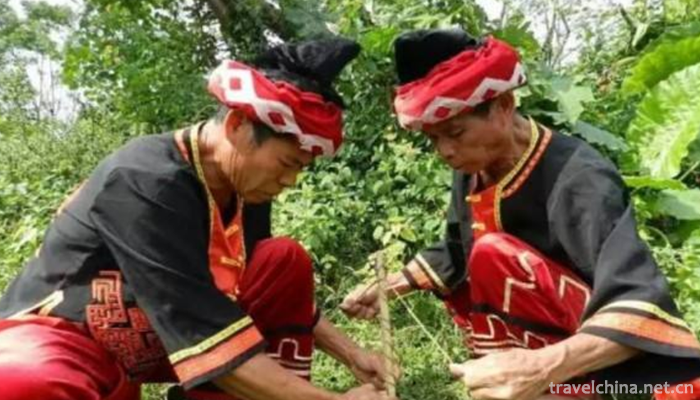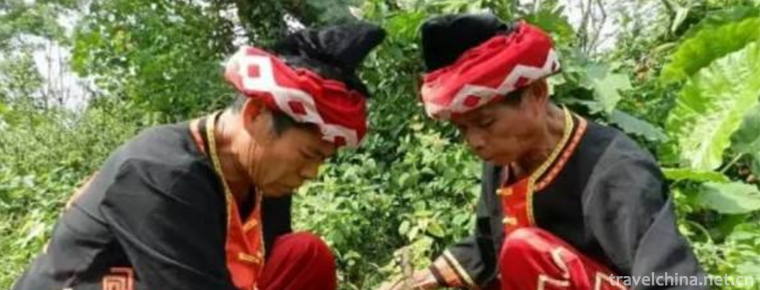Li Nationalitys Wood Drilling and Fire making Techniques
Li Nationalitys Wood Drilling and Fire making Techniques
Li people's wood-drilling and fire-making skills, Hainan Province's local traditional handicraft, one of the national intangible cultural heritage.
When the technique is used to make fire, the drill rod is inserted into a small hole with the foot on the drill fire board, and the drill rod is rubbed by both hands, so that the mechanical energy can be turned into heat energy to generate Mars, which falls down along the trough and ignites the ignition. When the igniter smokes, the air is blown quickly to assist the ignition, which leads to the fire.
In 2006, the technology of drilling wood and making fire of Li nationality was approved by the State Council and listed in the first batch of national intangible cultural heritage list, number: _-87.
historical origin
According to historical records, about 3000 years ago during the Shang and Zhou Dynasties, the ancestors of the Li Nationality had settled in Hainan Island. Until the Ming Dynasty, the Li Nationality was still distributed throughout the island. During the Song, Yuan, Ming and Qing dynasties, with a large number of Han people from the mainland migrating to Hainan, the phenomenon of ethnic assimilation and migration in the island became more and more serious. A small number of Li people from the northern part of the island moved southward, most of them assimilated into the Han people. Today, Li people mainly live in the central and southern part of Hainan Island. It is in this hot soil of Hainan Island that the Li people have experienced a long history of accumulation and gradually formed their own unique culture. It is in this unique culture that the ancient skill of drilling wood and making fire has been spread to this day.
Lizu's wood-drilling and fire-making skills are mainly preserved in Sanya, Wuzhishan, Dongfang and other cities in the south-central part of Hainan Island, as well as Li's agglomeration areas in Qiongzhong, Baoting, Lingshui, Ledong, Changjiang and Baisha counties.
Process characteristics
producer
Lizu's wood-drilling and fire-making is one of all kinds of artificial fire-making techniques in ancient times, which has distinct regional characteristics. According to the production custom of Li nationality, the ignition of pottery must be carried out in the way of "drilling wood to make fire". Because it takes a lot of endurance to drill a wooden pole out of Mars, women can't do it, and weak old men can't do it.
Skill
In order to make the invisible Mars become a vigorous flame, one must have a medium, that is, to ignite it with flammable corduroy, banana root fiber, kapok and so on, and to lose the opportunity of oxygen transfusion, in order to achieve the purpose of fire.
Technological process
Lizu wood-drilling and fire-making tools are composed of fire-drilling board and drill pipe (or bow wood). The fire drill board is cut with soft numbness, generally 35 cm long, 7-10 cm wide and 3-5 cm thick. On one side of the fire drill board, a number of small holes are dug, and the bottom of the holes is a flowing ash trough, from which Mars falls. Drill pipe (or bow) is 50-60 cm long, made of hard miscellaneous wood, 3-5 cm in diameter, with a slightly pointed lower end, such as a cone. In addition, corduroy, banana root fiber, kapok and so on are used as ignition materials. When the fire is started, the drill pipe is inserted into a small hole with the foot on the drill fire board, and the drill fire rod or bow is rubbed by both hands, so that the mechanical energy can be converted into heat energy, resulting in Mars. Mars fell down the trough and ignited the ignition. When the igniter smokes, it is quickly picked up and blown for combustion, which leads to fire.
Inheritance and protection
Inheritance value
Lizu's drilling wood for fire has archaeological and historical value. As a cultural relic, the drill board, the drill rod or the bow wood can not speak. It is a kind of dead fossil. It is difficult to explain the process of drilling wood to make fire by these data alone. This can only be helped by the relevant ethnological materials as "living fossils".
Inheritance status
Nowadays, the necessity of drilling wood to make fire has long ceased to exist. There are not many people who know this skill. These old folk artists still have the method of drilling wood to make fire, and they need to take measures to rescue and protect it urgently.
Inheriting characters
Wang Zhaoliang, male. In May 2018, he was selected as the representative successor of the fifth batch of national intangible cultural heritage projects and declared by Baoting Li and Miao Autonomous County, Hainan Province. Project Name: Lizu wood drilling and fire technology.
protective measures
In May 2018, the Campus Tour of the intangible cultural heritage of Hainan Province was held in Baoting Middle School. The students of Baoting Middle School in Baoting Li and Miao Autonomous County learned the skills of drilling wood and making fire.
social influence
Important exhibition
In June 2015, Baoting held a "Baoting Li and Miao Autonomous County intangible cultural heritage exhibition activity" in the Penang Valley scenic spot, in which the Li people's wood drilling and fire-making skills were displayed.
In October 2015, Baoting held a "Tour Exhibition of Traditional Techniques of Non-material Cultural Heritage" in Yanoda Scenic Area, in which the drilling and fire-making skills of Li nationality were displayed.


-
1.Dayi Liushi Manorial Museum
Dayi Liu Manor Museum, located at No. 15 Jingui Street, Anren Town, Dayi County, Chengdu City, Sichuan Province, is one of the most important historical sites and representative buildings in modern Ch
Time 2018-12-26 -
2.Qinhu National Wetland Park
Qinhu National Wetland Park is located between the central part of Jiangsu Province and the Yangtze and Huaihe River. The total area of the scenic spot is 26 square kilometers.
Time 2019-02-07 -
3.Shanshan guild hall
Shanxi-Shaanxi Guild Hall is the place where Shanxi and Shaanxi merchants and businessmen associate with each other and worship gods. It combines exquisite architectural
Time 2019-02-08 -
4.Shenyang Forest Wildlife Park
Shenyang Forest Zoo is a state-level forest wildlife park approved by the State Forestry Administration and the Ministry of Construction. Located in the Chebanshan International Scenic Tourism Develop
Time 2019-02-08 -
5.Chentang Sherpa Singing and Dancing
Chen Tang Sherpa Song and Dance is a traditional folk song and dance in the Sherpa community of Tibet. Accompanied by "Zhanlie" (Six Strings) and "Biwang" (Huqin).
Time 2019-04-16 -
6.Dabie Mountain Folk Songs
Dabie Mountain folk song is a traditional folk song widely circulated in the west of Anhui Province. With the unique regionality of the interdependence of mountains and rivers
Time 2019-04-23 -
7.Buddhist music
Buddhist music, the music used by Chinese Buddhist temples and believers in religious ceremonies. Buddhism believes that music has the function of "offering" and "praising Buddha".
Time 2019-04-29 -
8.Mongolian Costume
Mongolian costumes, also known as Mongolian robes, mainly include gowns, belts, boots, jewelry and so on. However, there are differences in styles due to different regions. Mongolian costume has a str
Time 2019-06-03 -
9.Yingge Liushu
Yingge Liushu, also known as Yingge Liuzi, is a traditional art form of rap and singing spread in southwestern Shandong, southern Shandong, Eastern Henan and Northern Jiangsu. Legend has it that the L
Time 2019-07-14 -
10.Deyang secondary industry
In 2018, the total industrial added value of Deyang City was 101.28 billion yuan, an increase of 9.8% over the previous year. By the end of the year, there were 1376 Industrial Enterprises above Designated Size, and the added value of industries above
Time 2020-12-14 -
11.Leshan population
By the end of 2018, the total number of household registration in Leshan was 1 million 269 thousand and 500, and the household registration population was 3 million 506 thousand and 800. Among them, 1 million 290 thousand and 600 were urban household registration
Time 2020-12-17 -
12.Yibin local specialty
The production of bamboo spring, bamboo carving and bamboo weaving in Yibin city began in Yuan and Ming Dynasty, with excellent materials and local characteristics and life interests. Therefore, he became famous both at home and abroad and entered the court many times.
Time 2020-12-18